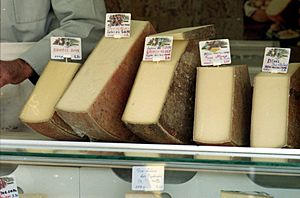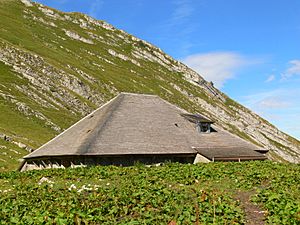Swiss-type cheeses facts for kids

Swiss-type cheeses, also called Alpine cheeses, are a special group of hard or semi-hard cheeses. They first came from the Alps mountains in Europe. Today, people enjoy them and make similar versions all over the world.
These cheeses got their unique style because they were made in the summer. Cows grazed high up in the Alpine grasslands, called alpage in French. When winter came, the cows and cheese were moved down to the valleys. This old tradition is known as Alpine transhumance. Traditionally, these cheeses were made in big round shapes, like "wheels," with a hard outer layer. This made them strong enough to store and transport easily.
Some of the most famous Swiss-type cheeses are made from cow's milk. These include the Swiss Emmental, Gruyère, and Appenzeller. From France, there are Beaufort and Comté. Comté comes from the Jura Mountains, which are close to the Alps.
Other Alpine regions also make traditional cheeses. Austria has Alpkäse, and Italy has Asiago. While these are great, they are not as well-known worldwide as the Swiss and French types. Jarlsberg cheese from Norway and Maasdam cheese from the Netherlands are also made using similar methods.
In North America, Emmental is often simply called "Swiss cheese." However, in Switzerland, people eat more Gruyère. In Europe, Gruyère is often seen as the classic Swiss cheese.
Swiss-type cheeses are "cooked" during their making process. This means they use special bacteria called thermophilic lactic fermentation starters. The cheese curds are heated to a high temperature, 45°C (113°F) or more. After heating, they are pressed to remove extra water. This is why they are also called "'cooked pressed cheeses'" (fromages à pâte pressée cuite in French).
Most of these cheeses have very few or no holes, or "eyes." If they do have holes, they are much smaller than the big holes you might see in some Emmental. These cheeses usually have a firm but springy texture. Their flavor is not sharp or salty. Instead, it's often nutty and buttery. When melted, they become soft, stretchy, and gooey, which is great for cooking!
Many traditional cheeses have special rules to protect how they are made. For example, in Switzerland, they have the Appellation d'origine protégée (AOP). These rules can cover everything from the type of cow and pastures used to where and how the cheese is made. They also set rules for how long the cheese must age.
Most modern cheese production is done in factories. These cheeses are often made in rectangular blocks and wrapped in plastic. This means they don't form a hard rind. Historically, all these cheeses were made with "raw" milk. The high heat used in making them helped control unwanted bacteria. Today, some modern cheeses use milk that has been heated (thermized) or pasteurized.
How Alpine Cheese Is Made
The way Alpine cheese is made shows the needs of the cheesemakers who moved with their cows. High up in the summer mountains, wood was easy to find for heating the cheese. But salt had to be carried up and was expensive. So, less salt was used compared to other types of cheese.
Alpine cheeses are made to be aged, usually for at least a few months, but often much longer. The cows would reach the high slopes around May and stay until October. They often moved higher as the snow melted. The highest grazing areas are around 2,800 meters (9,200 feet). Cheese was made during this time and stored before being brought down in the autumn. Sometimes, the same cows and herders made a different cheese from winter milk. Protected cheese types might even require milk from a specific season.
The Alpine cheesemaking process brought three important new ideas. First, the cheese curds were cut into very small pieces. This helped push out extra liquid called whey. Today, this is done by stirring the cheese with a "cheese harp," which has many metal wires. Other cheeses also cut the curd, but not into such tiny pieces.
Next, the curds were "cooked at high temperatures" and then pressed. Both steps helped remove even more moisture. The low acidity and salt in the cheese help certain bacteria grow. One important type is Propionibacterium freudenreichii subspecies shermanii. This bacteria creates gases, like carbon dioxide, which form the holes or "eyes" in the cheese. For a long time, large holes were seen as a mistake. But in the 1800s, Emmental makers started to encourage them. This was a clever marketing idea! Interestingly, Gruyère cheese used to have bigger holes than it does now.
Traditional Alpine cheeses are made in vats or "kettles" made of copper. Copper is required for many protected cheese types. However, factory-made cheese is often made in stainless steel vats. In North America, using copper for cheesemaking is even against the law. Some people think this is why North American cheeses don't always taste as rich as the original Alpine ones. In some places, very old copper vats are allowed to keep being used.
History of Alpine Cheese
Ancient stories tell us that the Roman emperor Antoninus Pius got sick and died in 161 AD after eating a lot of "Alpine cheese." This shows that Alpine cheese was made and could be transported hundreds of miles even back then.
During the Middle Ages, local monasteries helped spread Alpine cheesemaking. They owned large areas of mountain land that were not used much. The monasteries would collect cheese as a form of rent. One of the biggest was the Abbey of Saint Gall in Switzerland. It owned much of the Appenzell region starting in the 900s.
Another monastery, Muri Abbey, was founded in 1027. It received a large gift of wild Alpine land. The monks helped peasant families settle there by giving them tools and animals. Cheesemaking quickly became a key part of the new local economy. The cheese "rent" was delivered to the abbey every year on November 30. Often, about a dozen families would combine their cows for the summer. They would choose a main cowman and build high chalets (small houses) to make cheese in.
The very hard Italian "grana" cheeses, like Parmesan and Grana Padano, are related to Alpine cheeses. Even though they came from the flat, swampy Po Valley, they use a similar cheesemaking process. This started after local monasteries began draining the land in the 1000s. These monasteries were Benedictine and Cistercian orders. They had sister-houses that were already making Alpine cheese. It seems they borrowed the techniques but made different cheeses. They used much more salt and less heating, which fit the materials they had locally.
The Black Death in the mid-1300s greatly affected the Alps. It led to more cows being raised instead of sheep or goats. The Protestant Reformation also changed things. It removed the monastic landlords and some rules about eating cheese during Lent. By the 1500s, Alpine cheeses were becoming important products to sell to other countries. They were found to travel well on long sea voyages between continents.
Cheesemaking Gallery
Here are some steps in making French Beaufort cheese. Other "cooked pressed" Alpine cheeses are made in a very similar way.













